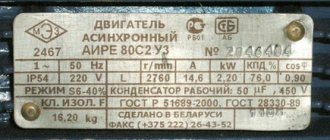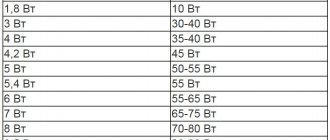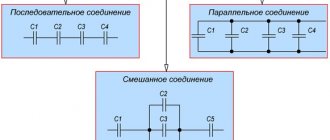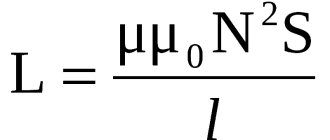What determines the amount of heat?
The internal energy of a body changes when work is performed or heat is transferred.
In the phenomenon of heat transfer, internal energy is transferred by conduction, convection or radiation. Each body, when heated or cooled (through heat transfer), gains or loses some amount of energy. Based on this, it is customary to call this amount of energy the amount of heat.
So, the amount of heat is the energy that a body gives or receives during the process of heat transfer.
How much heat is needed to heat water? Using a simple example, you can understand that heating different amounts of water will require different amounts of heat. Let's say we take two test tubes with 1 liter of water and 2 liters of water. In which case will more heat be required? In the second, where there are 2 liters of water in a test tube. The second test tube will take longer to heat up if we heat them with the same fire source.
Thus, the amount of heat depends on body mass. The greater the mass, the greater the amount of heat required for heating and, accordingly, the longer it takes to cool the body.
What else does the amount of heat depend on? Naturally, from the difference in body temperatures. But that is not all. After all, if we try to heat water or milk, we will need different amounts of time. That is, it turns out that the amount of heat depends on the substance of which the body consists.
As a result, it turns out that the amount of heat that is needed for heating or the amount of heat that is released when a body cools depends on its mass, on the change in temperature and on the type of substance of which the body is composed.
What does Q depend on?
Test No. 1 : Let's take two identical vessels. Let's pour water weighing 400 g into one of them, and vegetable oil weighing 400 g into the other. Let's start heating them using identical burners. Watching thermometer readings. We see that the oil heats up faster. This means that the amount of heat depends on the temperature. Experiment 2 : Take 1 kg of water and 1 kg of sunflower oil. Let's heat both vessels by 1 degree. 4,200 J were spent on heating water. And 1,700 J were spent on heating oil. From this we can conclude: The amount of heat depends on the type of substance.
A physical quantity that shows how much heat is required to heat 1 kg of a substance by 1 degree is called the specific heat capacity of the substance.
Denoted by the letter C. Measured in J, divided by kg, multiplied by degrees Celsius.
Experiment 3: Take 400 g of water in one vessel, and 200 g of water in another vessel. Let's heat both vessels by the same number of degrees. To heat 1 vessel, more heat was required. Conclusion: the amount of heat depends on mass.
How is the amount of heat measured?
A unit of heat is considered to be 1 Joule . Before the advent of the unit of measurement of energy, scientists considered the amount of heat as calories. This unit of measurement is usually abbreviated as “J”
A calorie is the amount of heat required to heat 1 gram of water by 1 degree Celsius. The abbreviated form of calorie measurement is “cal”.
1 cal = 4.19 J.
Please note that in these energy units it is customary to indicate the nutritional value of foods in kJ and kcal.
1 kcal = 1000 cal.
1 kJ = 1000 J
1 kcal = 4190 J = 4.19 kJ
Heat units
“...- How many parrots can fit in you, such is your height. - I really need it! I won’t swallow so many parrots!...”
From the film “38 Parrots”
According to the international rules of SI (International System of Units), the amount of thermal energy or quantity of heat is measured in Joules [J], and there are also multiple units kiloJoule [kJ] = 1000 J., MegaJoule [MJ] = 1,000,000 J, GigaJoule [ GJ] = 1,000,000,000 J. etc. This unit of measurement of thermal energy is the main international unit and is most often used in scientific and scientific-technical calculations.
However, all of us know or have heard at least once another unit of measurement of the amount of heat (or simply heat) is the calorie, as well as the kilocalorie, Megacalorie and Gigacalorie, which is what the prefixes kilo, Giga and Mega mean, see the example with Joules above. In our country, historically, when calculating tariffs for heating, be it heating with electricity, gas or pellet boilers, it is customary to consider the cost of exactly one Gigacalorie of thermal energy.
So what is Gigacalorie, kiloWatt, kiloWatt*hour or kiloWatt/hour and Joules and how are they related to each other?, you will learn in this article.
So, the basic unit of thermal energy is, as already mentioned, the Joule. But before talking about units of measurement, it is necessary, in principle, to explain at the everyday level what thermal energy is and how and why to measure it.
We all know from childhood that in order to warm up (receive thermal energy) we need to set something on fire, so we all burned fires; the traditional fuel for a fire is wood. Thus, obviously, when burning fuel (any: wood, coal, pellets, natural gas, diesel fuel) thermal energy (heat) is released. But to heat, for example, different volumes of water require different amounts of firewood (or other fuel). It is clear that to heat two liters of water, a few fires are enough, and to prepare half a bucket of soup for the entire camp, you need to stock up on several bundles of firewood. In order not to measure such strict technical quantities as the amount of heat and the heat of combustion of fuel with bundles of firewood and buckets of soup, heating engineers decided to bring clarity and order and agreed to invent a unit for the amount of heat. In order for this unit to be the same everywhere, it was defined as follows: to heat one kilogram of water by one degree under normal conditions (atmospheric pressure) requires 4,190 calories, or 4.19 kilocalories, therefore, to heat one gram of water a thousand times less heat will be enough – 4.19 calories.
The calorie is related to the international unit of thermal energy, the Joule, by the following relationship:
1 calorie = 4.19 Joules.
Thus, to heat 1 gram of water by one degree, 4.19 Joules of thermal energy will be required, and to heat one kilogram of water, 4,190 Joules of heat will be required.
In technology, along with the unit of measurement of thermal (and any other) energy, there is a unit of power and, in accordance with the international system (SI), this is the Watt. The concept of power also applies to heating devices. If a heating device is capable of delivering 1 Joule of thermal energy in 1 second, then its power is 1 Watt. Power is the ability of a device to produce (create) a certain amount of energy (in our case, thermal energy) per unit of time. Let's return to our example with water, to heat one kilogram (or one liter, in the case of water, a kilogram is equal to a liter) of water by one degree Celsius (or Kelvin, it makes no difference), we need a power of 1 kilocalorie or 4,190 J of thermal energy. To heat one kilogram of water in 1 second of time by 1 degree, we need a device with the following power:
4190 J./1 s. = 4,190 W. or 4.19 kW.
If we want to heat our kilogram of water by 25 degrees in the same second, then we will need twenty-five times more power, i.e.
4.19*25 =104.75 kW.
Thus, we can conclude that the pellet boiler has a capacity of 104.75 kW. heats 1 liter of water by 25 degrees in one second.
Since we got to watts and kilowatts, we should say a word about them. As already mentioned, Watt is a unit of power, including the thermal power of the boiler, but in addition to pellet boilers and gas boilers, humanity is also familiar with electric boilers, the power of which is measured, of course, in the same kilowatts and they consume neither pellets nor gas, and electricity, the amount of which is measured in kilowatt hours. The correct writing of the energy unit kilowatt*hour (namely, kilowatt multiplied by an hour, not divided), writing kW/hour is an error!
In electric boilers, electrical energy is converted into thermal energy (the so-called Joule heat), and if the boiler consumed 1 kWh of electricity, then how much heat did it produce? To answer this simple question, you need to do a simple calculation.
Let's convert kiloWatts into kiloJoules/seconds (kiloJoule per second), and hours into seconds: there are 3,600 seconds in one hour, we get:
1 kW*hour = [1 kJ/s]*3600 s.=1,000 J *3600 s = 3,600,000 Joules or 3.6 MJ.
So,
1 kW*hour = 3.6 MJ.
In turn, 3.6 MJ/4.19 = 0.859 Mcal = 859 kcal = 859,000 cal. Energy (thermal).
Now let's move on to Gigacalories, the price of which heating engineers like to calculate for various types of fuel.
1 Gcal = 1,000,000,000 cal.
1,000,000,000 cal. = 4.19*1,000,000,000 = 4,190,000,000 J. = 4,190 MJ. = 4.19 GJ.
Or, knowing that 1 kW*hour = 3.6 MJ, let’s recalculate 1 Gigacalorie per kilowatt*hour:
1 Gcal = 4190 MJ/3.6 MJ = 1,163 kW*hours!
If after reading this article you decide to consult with a specialist from our company on any issue related to heat supply, then come here!
What is specific heat capacity
Each substance in nature has its own properties, and heating each individual substance requires a different amount of energy, i.e. amount of heat.
The specific heat capacity of a substance is a value equal to the amount of heat that must be transferred to a body with a mass of 1 kilogram in order to heat it to a temperature of 1 0C
Specific heat capacity is designated by the letter c and has a measurement value of J/kg*
For example, the specific heat capacity of water is 4200 J/kg*0C. That is, this is the amount of heat that needs to be transferred to 1 kg of water to heat it by 1 0C
It should be remembered that the specific heat capacity of substances in different states of aggregation is different. That is, heating ice by 1 0C will require a different amount of heat.
How to determine specific heat capacity from a heating or cooling schedule
Using an example, we will show how to find the specific heat capacity from a graph of heating or cooling a body.
Given a solid body with a mass of 2 kilograms. Figure 5 shows how the temperature of this body depends on the amount of heat received. The amount of heat is plotted horizontally, and the temperature of a certain body in a solid state is plotted vertically.
Determine the specific heat capacity of the substance that makes up this solid.
Rice. 5. The figure shows how the temperature of a solid depends on the heat received
Solution:
The body was heated from \(\large t_{1} = 0 \left( C \right) \) to temperature \(\large t_{2} = 60 \left( C \right) \);
The temperature difference is 60 degrees Celsius.
Body weight 2 kilograms.
The amount of heat received is \(\large Q = 15000 \left( \text{J} \right) \).
Let's write down a formula that can be used to calculate thermal energy Q:
\[\large Q = c \cdot m \cdot (t_{\text{end}} - t_{\text{start}}) \]
Let us now substitute the values into this formula to determine the amount of heat:
\[\large 15000 = c \cdot 2 \cdot 60 \]
Divide both sides of the equation by 10:
\[\large 1500 = c \cdot 2 \cdot 6 \]
Now let's divide both sides of the equation by the number 6:
\[\large 250 = c \cdot 2 \]
Dividing both sides by 2, we obtain the specific heat capacity of the solid:
\[\large 125 \left( \frac{\text{J}}{\text{kg} \cdot \text{deg}} \right) = c \]
Answer: Specific heat capacity of a solid \(\large 125 \left( \frac{\text{J}}{\text{kg} \cdot \text{deg}} \right) \)
Note: Bodies can exchange thermal energy with other bodies. The exchange of energy will stop when thermal equilibrium occurs. To solve problems, you need to use the specific heat capacities of the materials from which the bodies are made. And in order to calculate the amount of heat transferred or received by a body, you need to be able to apply the law of conservation of energy and draw up a heat balance equation.
How to calculate the amount of heat to heat a body
For example, it is necessary to calculate the amount of heat that needs to be spent in order to heat 3 kg of water from a temperature of 15 0C to a temperature of 85 0C. We know the specific heat capacity of water, that is, the amount of energy needed to heat 1 kg of water by 1 degree. That is, in order to find out the amount of heat in our case, you need to multiply the specific heat capacity of water by 3 and by the number of degrees by which you want to increase the water temperature. So that's 4200*3*(85-15) = 882,000.
In brackets we calculate the exact number of degrees, subtracting the initial result from the final required result
So, in order to heat 3 kg of water from 15 to 85 0C, we need 882,000 J of heat.
The amount of heat is denoted by the letter Q, the formula for calculating it is as follows:
Q=c*m*(t2-t1).
Calculation of the amount of heat when mixing liquids
Hot water was diluted with cold water and the temperature of the mixture was $30 \degree C$. Hot water with a temperature of $100 \degree C$ was $0.3 \space kg$. The cold water had a mass of $1.4 \space kg$ and a temperature of $15 \degree C$. Calculate how much heat was given up by hot water when cooling and received by cold water when heated. Compare these amounts of heat.
Given: $c_1 = c_2 = c = 4200 \frac{J}{kg \cdot \degree C}$ $m_1 = 0.3 \space kg$ $m_2 = 1.4 \space kg$ $t_1 = 100 \degree C$ $t_2 = 15 \degree C$ $t = 30 \degree C$
$Q_1 — ?$ $Q_2 — ?$
View solution and answer
Hide
Solution:
Let's write a formula for calculating the amount of heat given off by hot water when cooling from $100 \degree C$ to $30 \degree C$: $Q_1 = cm_1(t_1 - t)$.
Let's calculate this value: $Q_1 = 4200 \frac{J}{kg \cdot \degree C} \cdot 0.3 \space kg \cdot (100 \degree C - 30 \degree C) = 1260 \frac{J}{\degree C} \cdot 70 \degree C = 88 200 \space J = 88.2 \space kJ$.
Let's write a formula for calculating the amount of heat received by cold water when heated from $15 \degree C$ to $30 \degree C$: $Q_2 = cm_2(t - t_2)$.
Let's calculate this value: $Q_1 = 4200 \frac{J}{kg \cdot \degree C} \cdot 1.4 \space kg \cdot (30 \degree C - 15 \degree C) = 5880 \frac{J}{\degree C} \cdot 15 \degree C = 88 200 \space J = 88.2 \space kJ$.
$Q_1 = Q_2 = 88.2 \space kJ$.
Answer: $Q_1 = Q_2 = 88.2 \space kJ$.
In the course of solving this problem, we saw that the amount of heat given off by hot water and the amount of heat received by cold water are equal. Other experiments give similar results.
Means,
If heat exchange occurs between bodies, then the internal energy of all heating bodies increases by as much as the internal energy of cooling bodies decreases.
In practice, it often turns out that the energy released by hot water is greater than that received by cold water. In fact, when hot water cools, it transfers some of its internal energy to the air and the vessel in which mixing occurs.
There are 2 ways to take this factor into account:
- If we reduce energy losses as much as possible, we will achieve an approximate equality of energy given and received
- If we calculate and take into account energy losses, we can obtain the exact equality











